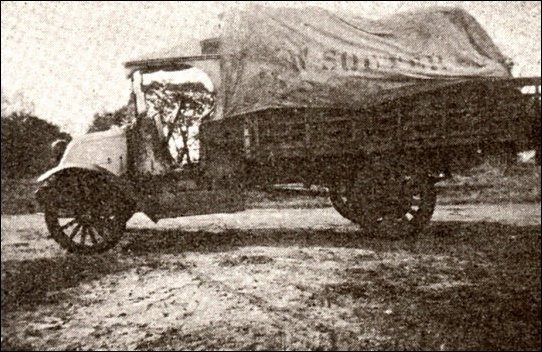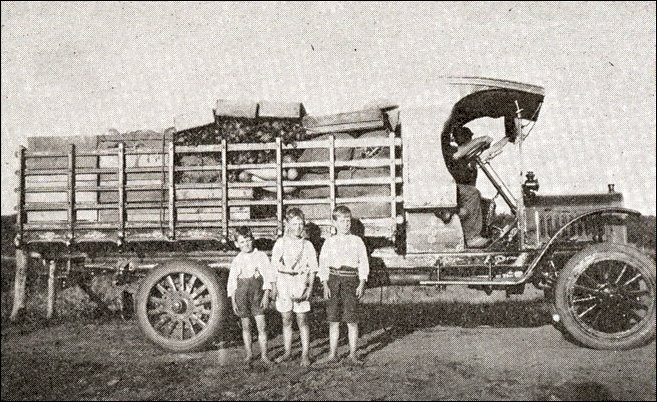Death of Bluey: The Market Gardener’s Truck

Bluey, the Bullnose International.
The accompanying photograph is of my father’s truck, a 1914 Bullnose International, taken about 1929, the year the first six cylinder Chev truck came out, so this should give a fair idea of our financial status at that time. The history of this truck and one of its successors I will list to the best of my memory.
This truck was formally a petrol delivery truck belonging to ‘Neptune’ Oil Co., now Shell. It was known affectionately throughout the district as ‘Bluey’ and on the bonnet painted in tar was the word Beware. It was in this truck that I went for my driving license at Springvale, me behind the wheel, the old man in the centre and the law on the outside. The most notable fact about this part of history is firstly, it was a sort of shotgun affair, my next eldest brother having had a slight disagreement with the management, I had to obtain a licence so that I could legally take the load to market the next day, and secondly there was so much slack play in the steering so that I kept my left hand in a loose but constant place on the steering wheel in an endeavour to conceal this fact, while I secretly steered the truck with my right.
Of course over the years the truck gradually wore out. The differential was the next to get the same complaint, but nothing that could not be cured by packing up with tin. Now at that stage, not having the required skill in such intricate engineering technicalities, this caused the diff to produce the greatest howl imaginable. Rather embarrassing too, because in those days I used to deliver produce to various shops on the way to market. My first two calls from home used to be Tony De Lorenzo, North Brighton and Vince Lazzaro, Middle Brighton. One particular night I was persuaded to deliver to Vince first, as a result arriving rather late at Tony’s, whereupon he accused me of so doing. I said, “No, I just left home a bit later”. He said, “you tella the lie, I hear your truck leaving Middle Brighton.”
The next part of the truck’s anatomy to receive the benefits of my engineering skill was the water pump gland, which I felt I could successfully pack with plenty of grease and part of the brim of the old man’s hat. We gave it a preliminary trial and sent a load off to market. As the truck came home the next day, I very proudly asked my brother how she went. To my surprise the resultant description of my engineering ability could not be repeated here. I said “But there’s no water coming out.” “There’s no b**** water left in it,” he yelled.
The funny think about all this was that my two eldest brothers thought that we were getting such a good run out of this old Bullnose that they decided to buy one the same model. I well remember going to market in their truck with Tom, who was the market man for that partnership. In those days most spare tyres on cars were carried at the rear. On the way home a car suddenly stopped in front of us. These old Bullnose trucks, as with most other trucks of that era were noted for their lack of braking power with the result that our crank handle went through this bloke’s spare tyre. The result was an exchange of a few well chosen words. After we again became mobile, Tom with a rather red face and very grim look said, “I’ll make these b***** brakes work.” At the same time he stood on the pedals and pulled on the three foot hand brake. Yep, another car ran into the back of us.
The leaking radiator on this truck always seemed to tax my genius. As the photograph shows it was at the rear of the engine. One never went to market without a four gallon tin for refilling. I knew every front garden tap and horse trough from Dingley to the Victoria market. I tried solder, cement, and molten sulphur poured through the core. This had no more success stopping the leaks than the other means. Two other sure cures given to me were white of an egg and also oatmeal. Still no success, the only result being that people like Tony De Lorenzo not only heard me coming, felt me rumble by, but smelt me after I’d gone.
The cooling problems finally got me down, so we redesigned the motor and mounted a ‘Morris London’ radiator in front of the motor. This opened up a whole field for my inventive genius. In keeping with the new ‘radiator in front’ mod look, built a complete new cab with the latest mod cons. Doors instead of the traditional manure bags nailed on the sides, seat with real springs put an end to the part filled bag of chaff that had acted as such for so many years. The new seat was a triumph of inventiveness. It was reversible. For driving I sloped it forward to give me more leverage on the massive brake and clutch pedals while for sleeping in the market, turned the slope backward so that I didn’t keep falling out of bed as with the chaff bag seat.
I mounted a ‘T’ model generator where the rear fan used to be and graduated from gas headlight to electricity. One drawback was the generator spun so slowly that it did not generate until a fairly high speed was reached. I well remember hurtling along St Kilda Road one Friday night (20 m.p.h.) generator charging 2 amps so I knew I had lights, when a fellow came out of a side street on my left. Brakes as previously described so when I finally stopped I had him tipped over on two wheels at a 45 degree angle. He was looking up through his side window at a load stacked four cases high over the new cabin. I backed off and lowered him to four wheels. You could see the perspiration on his face and I distinctly heard him say ‘cheese’, so did I and we took off in different directions.
For some reason or other whether it was satisfaction for service or lack of finance we bought another Bull Inter, although this one was a later model 1918. It was carefully overhauled and was almost ready for the road when the axe finally fell on Bluey. It was a very wet and windy night on the way to the market. Almost opposite the Shrine and just past the last horse trough stop before the Victoria Market when I get from a patrol, a polite but firm invitation to pull over. They must have had X-ray eyes, because between them they listed every known fault and all this before the days of road worthy certificates. In my innocence I said “what made you pull me up.” There was nearly an explosion, but amongst it all I deciphered the words “no tail light”. I went around the back to look and immediately explained that as it was so windy, I had turned the kerosene light up so high that it had blackened the glass. Then they diverted the attack to the tyres. Solid rubber of course, but on one of the back wheels the rubber had lifted for almost half the wheel. On the wet road this had added another exclusive and distinctive sound to the already mentioned one, a sort of continuous thump, clack. He said I would ruin the road driving a thing like that.
Perhaps it was me who loosened all those red gum blocks that used to pave St Kilda Road. Finally, I told him it was the last trip the truck was making which opened up a whole new avenue for his comments, his last words to the effect that they would be watching for me.
The weekend a hurried transfer of the body, number plates, etc. even the engine number, and so … the death of ‘Bluey’.

Bill Souter with his three children, Harry, Mike and Joe at Dingley c1924. Courtesy Charlie Souter.
Footnotes
- First published in the Victorian Vegetable Grower, February, 1973.
- Joe Souter and his family were market gardeners in Dingley.
